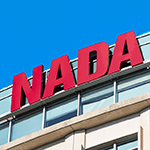NADA Releases Third Quarter 2022 U.S. Auto Sales Analysis
TYSONS, Va. (Oct. 12, 2022)—The National Automobile Dealers Association (NADA) issued its analysis of U.S. auto sales and the economy following the end of the third quarter of 2022.
“While we saw September 2022’s SAAR improve only slightly at the end of this quarter compared to August, there was a significant 9.6% improvement compared to September 2021’s SAAR,” said NADA Chief Economist Patrick Manzi. “Limited inventory remains the key pain point for new light-vehicle sales, but thankfully inventory on the ground and in transit has finally started to increase meaningfully.”
The third quarter of 2022 closed with a new light-vehicle sales totaling a quarterly average SAAR of 13.3 million units, down slightly from a SAAR of 13.4 million units during the second quarter of the year.
Inventory at the end of the third quarter of 2022 was up 44.3% compared to the start of the year, when inventory levels were just below one million units on the ground and in transit. The month of September ended with inventory at 1.43 million units on the ground and in transit – up 12.7% from the beginning of the month. The market has experienced double digit month-over-month percentage increases in inventory for two straight months, but the increases aren’t shared equally by all manufacturers with some OEMS still struggling with shortages of key production inputs.
Alternative-fuel vehicle market share, including battery electric, hybrid and plug-in hybrid vehicles, grew to more than 12% through September 2022; in the same period in 2021, alternative-fuel market share had not reached double digits with a market share of 9%. Through the third quarter, battery electric vehicles (BEVs) accounted for 5.1% of sales, hybrid vehicles accounted for 5.7% and plug-in hybrid vehicles (PHEV) accounted for 1.3% of new light-vehicle sales.
As more and more BEVs hit dealership showrooms across the country, the share of BEVs sold by franchised dealerships continued to grow. Since the beginning of the year, franchised dealerships sold more than 175,000 of the 515,000 BEVs sold, 34% of all BEVs sold. During the third quarter of 2022, BEV sales by franchised dealerships surpassed 2021’s full year total when franchised dealerships sold just over 135,000 BEVs.
On the pricing side, the average new light-vehicle transaction price in September 2022 totaled $45,625, up 6.3% year-over-year, according to J.D. Power. The average monthly payment for a new vehicle in September 2022 rose to $708, up $52 year-over-year and the third straight month of average payments above $700 since breaking the $700 barrier for the first time in July 2022.
Average incentive spending per unit rose slightly to $984 per vehicle during the month but still didn’t top $1,000, making it the fifth consecutive month of below $1,000 per unit incentives.
According to J.D. Power, the average interest rate on a new vehicle finance contract reached 5.71% in September 2022, up 170 basis points year-over-year. The average interest rate on new and used vehicle finance contracts has now risen above pre-pandemic levels for the first time and rates are expected to climb higher as the Federal Reserve continues to increase the Fed Funds Rate to cool the economy and tamper inflation.
The Federal Reserve has increased the Fed Funds rate five times this year and rates currently sit at a targeted range of 3% to 3.25%. By the end of the year, NADA anticipates that the Fed Funds rate will be greater than 4%.
Key measures of inflation still remain elevated. According to the U.S. Department of Commerce Personal Consumption Expenditures Price Index, consumer prices rose 6.2% in August 2022 from August 2021, easing slightly from 6.4% year-over-year increase in July. Another measure of inflation, the U.S. Bureau of Labor Statistics Consumer Price Index rose 8.3% in August from the same time in 2021.
“Increasing borrowing costs and higher prices have dented consumers buying power and will weigh on consumer demand through households pulling back on spending which will lead to slowing growth,” added Manzi. “While we don’t currently believe the U.S. economy is in a recession, the likelihood of entering one in the next six to nine months has increased.”
Heading into the final quarter of 2022, the U.S. new vehicle market is finally starting to see signs of improving new vehicle inventories just as borrowing costs and monthly payments are rising to post-pandemic highs. Although North American light-vehicle production and inventory levels have improved somewhat, they have not recovered enough for new vehicle sales to reach NADA’s most recent forecast of 14.2 million units. As a result, NADA has reduced its full year 2022 new light-vehicle sales forecast to 13.8 million units.
“The current environment will likely push many consumers out of the new vehicle market,” said Manzi. “Despite some demand destruction, we still expect that any excess retail demand will be happily taken up by large fleet buyers who have struggled to replace their aging inventories during the past two-and-a-half years. And even with a forecasted lower total sales volume compared to 2021, we still expect that 2022 will be another very solid year for America’s franchised dealerships.”
Click here to read the full September 2022 NADA Market Beat report.
Media Contacts

Jared Allen

